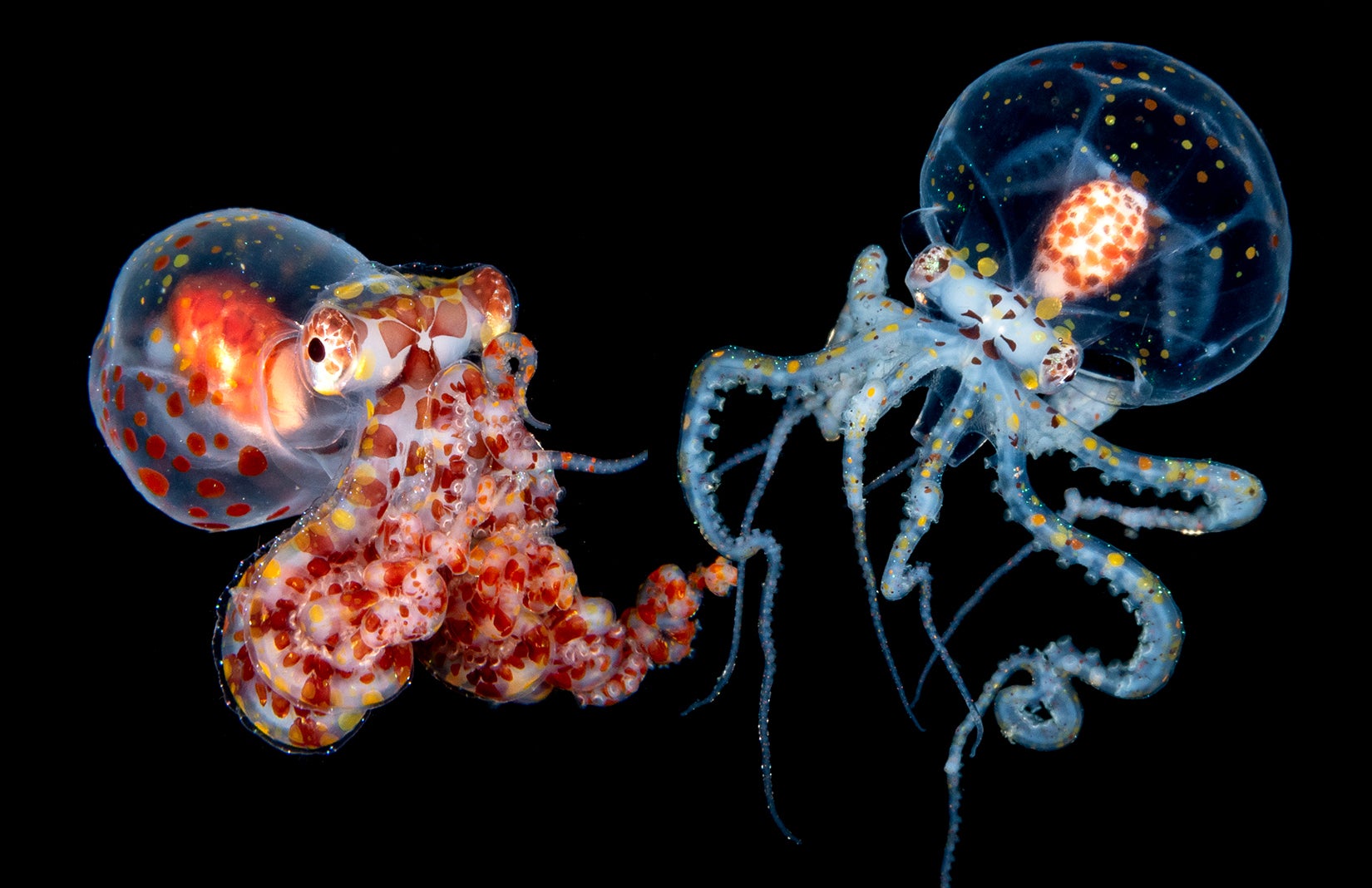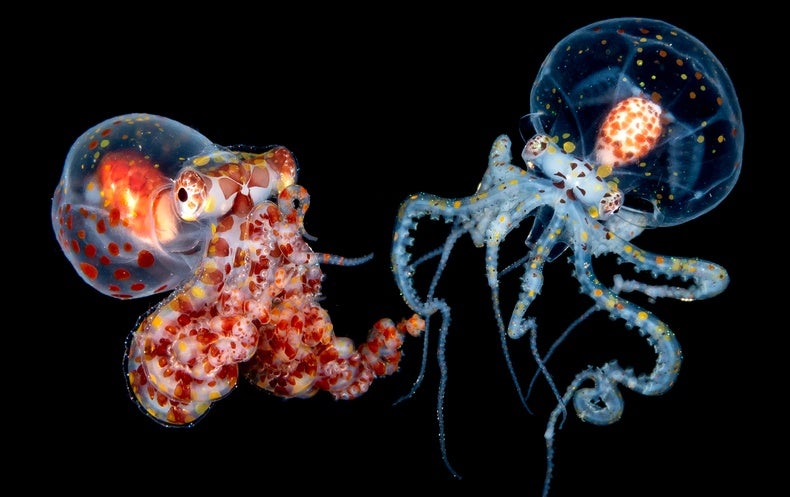
Every night at sundown, a great mass of mostly small sea creatures rises up from the depths into the topmost layers of the planet’s oceans. This daily vertical migration is the largest on Earth—an estimated 11 billion tons of animal biomass travels miles upward each night and then, before the sun rises, returns back to the dimly lit “twilight zone” below. The animals make this journey to feed on the organic material closer to the water’s surface and do so at night to avoid being eaten by the larger predators swimming there.
The nighttime migration was first discovered in the 1940s by the U.S. Navy, whose new sonar technology began pinging congregations of objects in the water column. Since then researchers, hobby divers and photographers have gone out to scuba dive at night and observe these nocturnal creatures.
For Linda Ianniello and Susan Mears, this so-called blackwater diving has evolved from a pastime into a passion. The two met in an underwater photography club in Florida, and both tried their first night dive after another member of the club recommended it to them more than seven years ago. “I never imagined doing this type of photography,” Mears says. But since she started, she hasn’t done any other kind.
Blackwater diving is done at night to a maximum depth of 60 feet, and divers are tethered to their boat by a rope. A light attached to a diver’s underwater camera illuminates the dark water in small patches, helping that person spot tiny animals (some no bigger than a pea), which are often mostly transparent and fast-moving.
To identify some of the creatures they captured on film, Ianniello, Mears and her husband Jim Mears, began posting pictures to a Facebook group with other blackwater diving enthusiasts. Soon scientists at the invertebrates group at the Smithsonian Institution and the Florida Museum of Natural History took notice and helped identify specimens. Many of the creatures had never been seen in their natural environment before—until then most had only been caught in nets, which mangled their body and appendages. The researchers and amateur photographers quickly developed a useful exchange of information. “It turned out to be a win-win on both sides,” Ianniello says. Even so, several specimens Ianniello and Susan and Jim Mears photographed have yet to be fully identified at the species level. Ianniello and Susan Mears published a book of their photography in 2018.
Vertical migration in the oceans is thought to play a crucial role in sequestering atmospheric carbon dioxide in the deep sea. The migrating animals feed on photosynthetic phytoplankton nearer the surface, which have absorbed atmospheric carbon dioxide. The creatures then return to the deep pelagic zone, where they deposit that organic, carbon-rich material as waste. Despite this crucial service, relatively little is known about these creatures. Simultaneously their habitat and life cycle are being affected by warming seas and underwater drilling activities. So a glimpse of them in their natural habitat is a major advancement toward understanding these mysterious yet ubiquitous animals.
Sea butterflies are mollusks that live their whole life in the upper layers of the ocean. This adult specimen photographed in Florida is approximately the size of a quarter or a little bigger. The glowing bulb at the center of its body is its stomach.
Box jelly off the coast of Florida at a depth of about 30 to 40 feet. This larva is between about two and two and a half inches. Unlike some other varieties found around the world, box most box jellies in this region sting but are not fatal.
Mantis shrimp larva off the coast of the island of Lembeh in Indonesia, about an inch long. When fully grown, these carnivorous creatures use their forelimbs to prey on hard-shelled mollusks and fish.
Larval tube anemone from Florida: To help scientists learn more about these creatures, Susan Mears and Linda Ianniello get photographs of the animals in their natural environment and have also begun collecting samples to be analyzed by invertebrate researchers. Many samples have yet to be identified.
When she first saw this gargoyle cusk eel in Florida, Mears mistook it for a bony-eared assfish—another type of cusk eel. “I was thrilled to see it. I thought, ‘Oh my gosh, wow.’” Usually found in deep water, the adult gargoyle cusk eel is extremely rare and represents the only member of its genus.
Sharpear enope squid in Florida: Adults of this species live in deep water and are rarely seen. This larva is about fingernail-size.
Larval thimble jellyfish in Florida: Larvae that get under people’s bathing suit sting their skin and cause “seabather’s eruption,” an itchy rash. Ianniello says she’s seen fewer of these creatures in the past five years, but the cause remains unknown.
Eel larva in Florida: This specimen is about three to four inches long. These larvae are transparent, fast-moving and hard to photograph, Ianniello and Mears say. They periodically curl up, presumably in a defensive posture, and slow down or stop, Ianniello says, making them easier to shoot.
Tube anemone in Florida: Susan calls these creatures “huge,” at nearly three to three and a half inches. Tube anemones can spread out and shrink their larger tentacles around the smaller feeding tentacles at the top of their body.
Alciopedia: A pelagic worm with eyes capable of forming an image.

























































